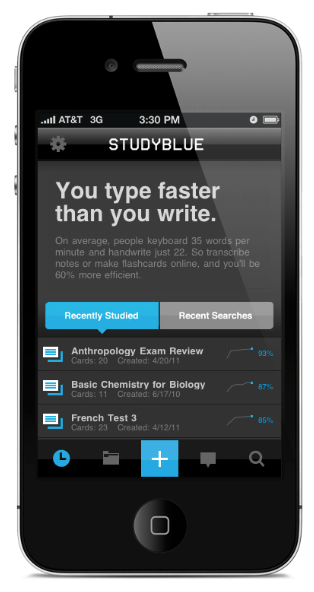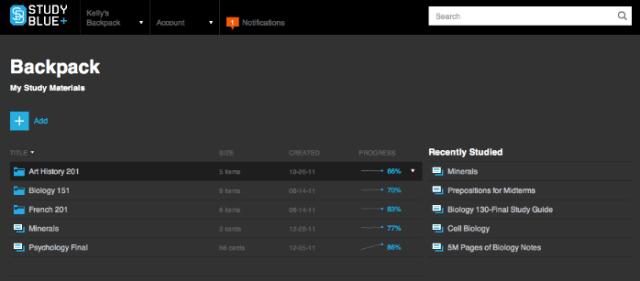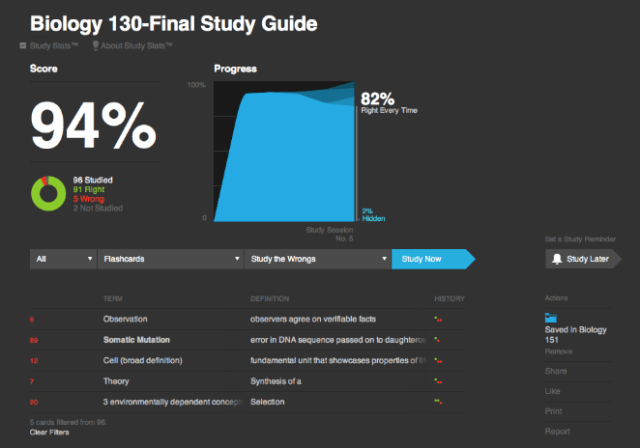Founded in 2009, Wisconsin-based startup StudyBlue set out with a simple and straightforward mission: Leverage technology to help students improve their academic performance. Over the next year, with smartphone adoption accelerating, that took a more defined shape, with StudyBlue becoming laser-focused on mobile to allow students to study anywhere and everywhere — across devices.
Today, StudyBlue has become a “digital backpack,” with its web and mobile study tools enabling college and high school students to store and organize their course materials, turning them into flashcards, quizzes and study guides that can be accessed on the go. By allowing students to share the content they create with others, the startup has amassed an enormous library of user-generated study materials — over 100 million in total — which cover a wide array of subjects, from zoology to anthropology.
The free platform has attracted 2.5 million students to date, 1.5 million of which have signed on in the last year. Thanks to this accelerating growth, StudyBlue announced today that it has raised $9 million in series A-1 financing, led by Great Oaks Venture Capital. The Wisconsin Alumni Research Foundation (WARF), a private, nonprofit organization that helps transform university research into products that benefit society, also contributed to the investment.
The investment adds to the $5.8 million the startup has raised in seed and series A funding — all of which came from angel investors — bringing its total to $14.8 million. With its new capital in the bank, the startup plans to continue scaling its team (now at 18), operations and support services to keep up with its growth, along with devoting more attention to its international user base by expanding support to include more localization, languages and inclusion for students across the map.
 In 2009, 100 percent of StudyBlue users were university students, but today high school students and teachers now represent over 30 percent of its user base and, next, the startup wants to make middle school a bigger share of that 30 percent.
In 2009, 100 percent of StudyBlue users were university students, but today high school students and teachers now represent over 30 percent of its user base and, next, the startup wants to make middle school a bigger share of that 30 percent.
“We are experiencing rapid growth,” said StudyBlue CEO Becky Splitt, “and this financing allows us to further expand our community and platform to help students master their course material faster and connect students to a comprehensive crowd-sourced library of content on nearly any subject, and to each other, in a highly relevant way.”
With a series A crunch in bloom (depending on whom you ask, of course), StudyBlue’s $9 million raise is a clear validation of the accelerating growth it’s been able to build over a fairly short period of time — a comparatively large early-stage financing for the EdTech world. Of course, as the industry transforms, education startups are beginning to find a more willing audience for their mobile and online apps, tools and platforms. Models are shifting such that startups can now more directly target students and teachers, and the demand is rising in kind.
Even though users bases are slowly beginning to grow among edtech companies, monetization still remains a challenge. Thanks to its new raise, there’s less urgency on the revenue front for StudyBlue, yet nonetheless, it’s begun to set the table by offering a freemium model with premium subscription and ad revenue. The platform’s core functionality is available to all for free and those who want more robust features — like an equation editor, advanced search filters, offline mode or to remove ads — can choose from one of two premium subscriptions at $1 and $5 per month, respectively.
Over time, the startup will also look to begin testing supplementary revenue streams by offering students opportunities to learn about sponsored offers from third-party sites they find relevant, in turn providing companies and brands access to a much-coveted demographic. For now, StudyBlue is focused on a bottom-up, direct-to-students approach, but there’s potential for the startup to tap into districts, which it can do more effectively as more teachers become aware of the service and recommend it to their students.
To that point, middle school and high school teachers have begun to discover the platform’s appeal as an effective tool for helping their students learn the material they teach and the StudyBlue CEO tells us that teachers increasingly requested the ability to add material themselves. So the startup recently added the ability for teachers to identify themselves to students so that they can find material shared by their teachers. As it goes forward, it will look to expand this functionality for teachers.
While there are a number of startups attacking this space, Splitt sees StudyBlue’s primary competition coming from Study Materials 1.0 — i.e. pen and paper. There’s BenchPrep, which offers premium content from top educational publishers and looks to personalize the learning process, Quizlet for flashcards, eBook providers for textbook-based quizzes and even crowdsourced giant Wikpedia, but none are offering the full package, the CEO says.
“We think we can be the only platform that dynamically connects students to each other and their shared content in the process, while leveraging the exciting capabilities now possible thanks to fast-maturing web, mobile and social channels.”
For more, find StudyBlue at home here.
































Comment